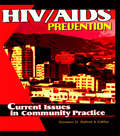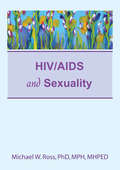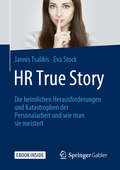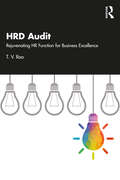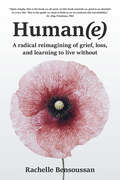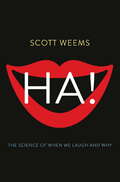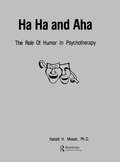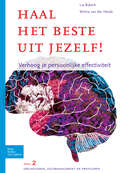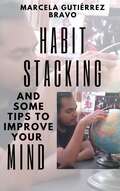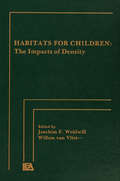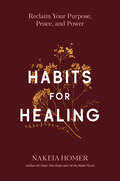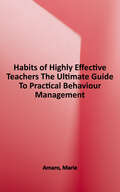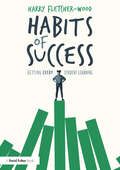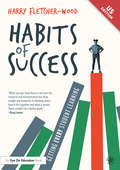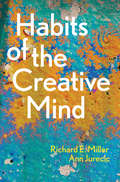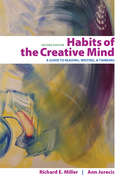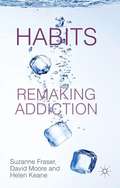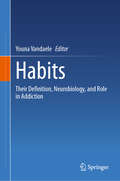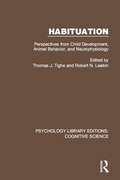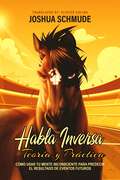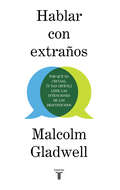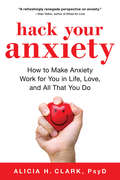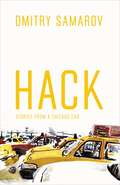- Table View
- List View
HIV/AIDS Prevention: Current Issues in Community Practice
by Doreen D. SalinaDevelop a positive working relationship between researchers and community groups focusing on HIV/AIDS prevention, and discover how to evaluate HIV/AIDS programs! An indispensable manual for everyone involved with HIV/AIDS research, prevention techniques, and the needs of individuals with HIV/AIDS, HIV/AIDS Prevention: Current Issues in Community Practice covers everything from the likelihood of condom usage by college women to the psychological effects on minority men infected with the HIV/AIDS virus. Essential reading for psychologists, research scientists who work with communities or who are involved in AIDS prevention programs, and for care takers of people with HIV/AIDS, Contemporary Topics in HIV/AIDS Prevention covers the necessary collaborative steps needed to create a positive researcher/community based organization (COB) partnership that will benefit researchers and those affected by the disease. In HIV/AIDS Prevention, you will examine many different models designed to effectively foster a positive researcher/CBO relationship while learning how to overcome problems you may encounter when researching a social issue or working with a researcher. This book also explains how and why many HIV prevention programs have been poorly evaluated due to a lack of funds and social politics. In addition, you will discover how you can obtain and/or perform a true evaluation of an HIV prevention program. In HIV/AIDS Prevention, you will explore many important issues and factors that help create successful programs, including: factors necessary for valid HIV/AIDS prevention program evaluations assessments of coping strategies, psychological variables, and the physical well-being of African- American and Latino men living with HIV/AIDS steps for the collaborative process between researchers and community groups making a good match between community-based organizations and researchersHIV/AIDS Prevention gives you pertinent information and guidelines for selecting a community-based organization to work with and the steps to creating a successful relationship. This book will give you the strategies and information you need in order to give pastoral support and prevention education to at-risk individuals. You will discover what is necessary for a true HIV/AIDS prevention program evaluation.
HIV/AIDS and Sexuality
by Michael W RossIn this important book, editor Michael Ross brings together the latest knowledge and research concerning the relationship between HIV and AIDS and sexual functioning. HIV/AIDS and Sexuality explores the experiences of being HIV-infected and the impact of infection on an individual's sexuality. It describes differences that may be associated with individuals who are infected or concerned about infection, and it provides new in-depth analyses of the effect of HIV on sexuality and sexual risks. The book provides clinical perspectives on sexual problems associated with HIV infection as well as some treatment approaches. Contributing authors represent the United States, Australia, and Europe and discuss heterosexual men and women, gay men, lesbians, and injecting drug users. This diversity provides a more complete picture of the experiences of people with HIV in terms of explicit and implicit sexuality. Chapters include cross-sectional and cohort study designs as well as qualitative, quantitative, and clinical approaches. Some of the topics explored are:the centrality of sexuality to equality of life and identity and the impact of HIV on sexuality in gay-identified menthe psychological impact of making changes in sexual behavior on gay men with HIV infectionrisk behaviors in seropositive and seronegative womena study of a cohort of HIV-infected women associated with the militarysexual addiction in gay men and its association with HIV risksovert and subtle communications processes that occur between health care providers and clients about sexuality and HIVstages of change in safer sexual practices in a cohort of gay menpersonality variables associated with risk and infection in both homosexual and heterosexual menHIV/AIDS and Sexuality opens up the area of sexuality in people living with HIV and focuses much-needed attention on the issues involved in sexual expression, HIV transmission risk, and living with HIV infection. This book is an illuminating exploration into the subject that helps professionals better understand their clients and thus provide more compassionate and effective care.
HR True Story: Die heimlichen Herausforderungen und Katastrophen der Personalarbeit und wie man sie meistert
by Jannis Tsalikis Eva StockDieses Buch schildert ehrlich und schonungslos die Realität von Personalverantwortlichen In diesem Buch über Tabuthemen im Human Resources Management stellt Autor Jannis Tsalikis Geschichten zu folgenden Themen in anonymisierter Form vor:Alkohol und Drogen am ArbeitsplatzBeziehungen und sexuelle Verhängnisse in der BelegschaftDiebstahl und Betrug am ArbeitsplatzEntlassungen im kleinen und großen StilDiskriminierung und Mobbinguvm. Tsalikis behandelt in seinem Werk ausschließlich Fallbeispiele aus dem echten Personalerleben. Diese sind zum Teil im Berufsalltag des Autors passiert, teilweise stammen sie von Kollegen aus dem Personalmanagement. Mit vielen konkreten Praxistipps Das Buch erzählt aber nicht nur echte Geschichten aus der Praxis von Praktikern für Praktiker. Jannis Tsalikis geht zudem mit Unterstützung von Experten aus Arbeitsrecht und Psychologie auf konkrete Tipps zum Umgang mit schwierigen Mitarbeitern und vielen weiteren Herausforderungen im Personaleralltag ein.
HRD Audit: Rejuvenating HR Function for Business Excellence
by T. V. RaoThis book presents the first ever comprehensive approach to evaluating and redesigning Human Resource Development (HRD) function and intervention to maximise their contribution to business excellence.The HRD function recognises the significance of competent and committed people in helping organizations achieve excellence. Studies across the globe have indicated that good HR systems and practices go a long way to make firms effective. Competent employees, top management, HR staff and the HRD climate play a critical role. This book examines how users of HRD are partners in any review and evaluation. It uses multiple methods like interviews with stakeholders, observation, questionnaires, analysis of documents and workshops. The book also outlines key HRD audit methodologies to review and rejuvenate HRD and align it with business excellence including intellectual capital building for the long term.An incisive and invigorating read, this book would be useful to the students, researchers, line managers, CEOs, CXOs and faculty of Human Resource Management, Organizational Behaviour and Applied Psychology. It would also be an invaluable handbook for practising business executives to help them implement the performance management and other talent management systems for leading excellence.
HUMAN(e): A Radical Reimagining of Grief, Loss and Learning to Live Without
by Rachelle BensoussanWritten by a Queer woman of North African and Middle Eastern descent, Human(e) takes a radically non-pathology-based approach to grief and loss. In this intimate and reflective auto-ethnographic book, Bensoussan asserts that grief is a biological imperative; a life-sustaining necessity that is vital to our survival. Human(e) explores how our species has been living with, and metabolizing loss, well before there were licensed professionals and accredited institutions. Bensoussan examines the inadequacy of the idea that grief is normal, as grief goes well beyond the Western-colonial binary of normal and abnormal. Grief is human, and to grieve is to be human. Rachelle seamlessly and beautifully weaves together her vast professional expertise on grief with her own personal lived experiences of loss. Human(e) is a must read for anyone learning to live without.
Ha!: The Science of When We Laugh and Why
by Scott WeemsAn entertaining tour of the science of humor and laughter Humor, like pornography, is famously difficult to define. We know it when we see it, but is there any way to figure out what we really find funny? In this fascinating investigation into the science of humor and laughter, neuroscientist Scott Weems uncovers whatOCOs happening in our heads when we giggle, guffaw, or double over with laughter. Beginning with the premise that humor arises from inner conflict in the brain, Weems explores such issues as why surprise is so important for humor, why computers are terrible at recognizing whatOCOs funny, and why cringe-worthy stereotypes make us laugh the hardest. From the role of insult jokes to the benefit of laughing for our immune system responses, "Ha " reveals why humor is so idiosyncratic, and why how-to books alone will never help us become funnier people. Packed with the latest research, amusing anecdotes (and even a few jokes), "Ha " is a delightful tour of why humor is so important to our daily lives.
Ha, Ha And Aha: The Role Of Humour In Psychotherapy
by Harold H. Mosak, PhD.First published in 1987. Routledge is an imprint of Taylor & Francis, an informa company.
HaWoS – Fragebogen zur Erfassung von Glück bei der Arbeit: Manual (Manuale zu Testverfahren und Fragebögen)
by Ricarda Rehwaldt Timo KortschDie HappinessandWork-Scale (HaWoS) ist ein Verfahren, das Bedingungen für Glück bei der Arbeit erfasst. Es handelt sich um ein mehrdimensionales Instrument der Organisationsdiagnostik, das als Ausgangspunkt einer Förderung von Glück im Arbeitskontext dient. Die HAWOS misst das Glücksempfinden der Mitarbeitenden einer Organisation im Arbeitskontext über zwölf Items anhand der drei Faktoren des Arbeitsglücks: Sinnempfinden, Selbstverwirklichung und Gemeinschaftsgefühl. Die Items der HAWOS sind berufsbezogen formuliert, die Entwicklungs- und Validierungsstudien wurden an Personen mit Berufserfahrung durchgeführt. Hintergrund: Für Beschäftigte gewinnt eine erfüllende Arbeit immer mehr an Bedeutung. Die HaWoS setzt mit der Erfassung von glücksförderlichen Bedingungen bei der Arbeit genau dort an. Mit dem validierten HaWoS können Ansatzpunkte für die Gestaltung der Arbeit identifiziert werden und Interventionen evaluiert werden. Die Zielgruppen: Arbeits-, Wirtschafts- und Organisationspsycholog*innen Personalentwickler*innen Personalverantwortliche, Management, Führungskräfte Coaches Organisationsberater*innen EinsatzbereicheDie HaWoS kann im Individual- und im Gruppenkontext angewendet werden. Die HaWoS bildet dabei den Ausgangspunkt für Interventionen oder Entwicklungsprozesse mit dem Ziel einer glücksförderlicheren Arbeitsgestaltung. Die HaWoS kann außerdem in Transformationsprozessen eingesetzt werden, die einen Kulturwandel zu einer sinnhafteren Arbeit zum Ziel haben.Durchführung, Auswertung und Interpretation· Sehr gute Testökonomie: Bearbeitungszeit von max. 5 Minuten· Testdurchführungen erfolgt digital oder „paper-pencil“· Online-Auswertung direkt im Testsystem mit grafischen Ergebnissen auf einem intuitiv nutzbaren Dashboard Gütekriterien· Objektivität ist durch standardisierte Durchführung und Auswertung gewährleistet.· Reliabilität: Mit Werten zwischen = .77 und = .86 im guten Bereich.· Validität: Bestätigung der faktoriellen sowie der konvergenten Validität in mehreren Studien.· Normierung basierend auf einer Normstichprobe von 3353 Personen liegt vor.
Haal het beste uit jezelf!: Verhoog je persoonlijke effectiviteit
by Lia Bijkerk Wilma van der HeideHoe kunnen studenten maximaal gebruik maken van hun kwaliteiten en interesses tijdens hun opleiding, in stages, bij het afstuderen en tijdens het werk? Hoe kunnen studenten beter omgaan met stress en met de tijd? Hoe kunnen zij betere gesprekken leren voeren en effectiever samenwerken? Hoe onderscheiden zij zich van de anderen en kunnen zij innovatieve producten en diensten verzinnen? Allemaal vragen die studenten graag beantwoord zien tijdens hun opleiding om gerichte keuzes te kunnen maken en om zo efficiënt en effectief mogelijk te studeren.In dit tweede deel van het boek voor studenten wordt de theorie van nog acht thema’s in het kader van persoonlijke effectiviteit beknopt beschreven. De hoofdstukken zijn overzichtelijk ingedeeld met daarin een praktijkvoorbeeld afkomstig uit het hbo, de beschrijving van de algemene competentie waaraan gewerkt wordt en een leertekst met voorbeelden, tips, modellen, vuistregels, do’s en dont’s. De hoofdstukken eindigen met praktische opdrachten en een doorverwijzing naar specifieke literatuur of websites die ondersteunend kunnen werken.Op de, bij het boek behorende website, kunnen studenten de testen uit het boek maken en de benodigde bestanden voor hun portfolio downloaden. Met behulp van dit boek kunen studenten de algemene competenties: organiseren, zelfmanagement en profileren vergroten. Het boek kan gebruikt worden als hulpmiddel bij lessen in het kader van de studieloopbaanbegeleiding of als ondersteuning bij regiekring bijeenkomsten. Studenten kunnen het boek ook individueel doorwerken om het beste uit zichzelf te halen.
Habit Stacking and some Tips to Improve Your Mind
by Marcela Gutiérrez BravoThe enormous library that the internet represents in our times has made people in favor of and against its effects in our habits, behavior, and even brain structure. The fact is that they will never agree if it is beneficial or not, as the individuals in the world are varied, as are their needs, habits, ideologies, and other aspects. In such a small nucleus, like a family, there can be discrepancies concerning said quandary. The truth is that it exists, and it is the main tool of our time. However, heads of households, teachers, and other similar people concerned over the moral good that this tool influences, have come to prohibit it in several places; this seems sad to me, as this tool contains all of the human knowledge up to today, and it would be a betrayal to our advance as a humanity, denying us the right to enjoy this knowledge. That’s why I have collected in this book, and in those that will follow, only some of the best ideas that the majority of professionals will suggest, that are found on the internet. After being a website and self-help book translator from four languages to Spanish, I have realized that not all languages have the same information on the internet. I have noticed, also, that there is very valuable information out there, but it is found in specialized blogs or in very lengthy articles that few people wish to read in their short navigation routine. This is the reason that I decided to do this collection. A book has a different manner. It claims a distinct moment for itself, just like the one network navigation claims for itself. It usually, barely gives us time to read publications that interest us, or manage to distract us, or improve our mood, stressed by the crazy and unending movement of the times that we live in. To that end, I have tried to present the material in the most enjoyable way possible and in small chapters that are good for reading while waiting in line, in transportation, in the last minutes of t
Habitats for Children: The Impacts of Density
by Joachim F. Wohlwill and Willem van VlietFirst published in 1985. Routledge is an imprint of Taylor & Francis, an informa company.
Habits for Healing: Reclaim Your Purpose, Peace, and Power
by Nakeia HomerHeal your past, start fresh, and create a life that honors the truth of who you are today. A leading well-being educator empowers you to turn concepts like boundaries and self-care into practical rituals with the power to transform your life.&“A powerful roadmap to help you break free of outdated patterns.&”—Mel Robbins, New York Times bestselling author, host of The Mel Robbins Podcast&“Gives you the tools to realize that you are truly worthy of building habits for healing.&”—Jamie Kern Lima, New York Times bestselling author of Worthy, founder of IT CosmeticsAs a former counselor and social worker, Nakeia Homer has helped thousands of people see that the journey from surviving to thriving begins with your habits. In Habits for Healing, Nakeia Homer sheds light on simple, powerful acts that move us toward healing and help us to escape patterns of burnout, toxic relationships, and emotional exhaustion. Drawing on her work guiding others and her own experience of healing from a traumatic childhood, she helps readers find healing in their everyday rhythms. For example:• A drive home from work can become an opportunity for self-care• Keeping a daily to-do list is a surprising way to ease into acceptance• The practice of becoming curious about others&’ motivations frees us from taking their words personallyThrough soul-stirring storytelling, life-affirming advice, and prompts for reflection, Nakeia Homer holds space for readers to feel what they feel, uncover the source of their difficulties, and live in their true power. Written with warmth and deep insight, Habits for Healing is the next inspiring step on your mental health journey.
Habits of Highly Effective Teachers: The Ultimate Guide to Practical Behaviour Management That Works!
by Marie AmaroWhat do I do when students won't stop talking? <p>How can I stop students wasting time and disrupting other students? <p>What can I do about disrespectful students? Sound familiar? <p><p> Difficult student behaviours can keep you awake at night! Effective classroom management can feel elusive and you feel isolated and incompetent dealing with students. Problematic student behaviour can lead to teacher stress, frustration and yes, even tears. You didn't learn about this at uni! <p><p> If you dream of a classroom where you can get on with the business of teaching and learning without being interrupted by poor student behaviour, Habits of Highly Effective Teachers is the book for you. <p><p> Well-regarded trainer, speaker and author Marie Amaro, has over 30 years' experience in the classroom. As a teacher, she really understands the unique challenges that face teachers today, the difficulties and demands on teachers and how to provide solutions that are achievable and easily implemented. <p><p> Learn what good teachers do, so you can do it too! <p> <p>- How to establish clear expectations for behaviour in the classroom <p>- The secret to building rapport with students while maintaining appropriate boundaries <p>- How to reduce conflict with students through prevention and early intervention <p>- Simple ways to reinforce expected behaviour throughout the day <p>- How to skilfully redirect inappropriate student behaviour <p>- Highly practical teaching strategies to motivate and engage students
Habits of Success: Getting Every Student Learning
by Harry Fletcher-WoodFor students to benefit from lessons, they must attend, listen and try their best. But at times, almost all teachers struggle to manage classroom behaviour and to motivate students to learn. Drawing on decades of research on behavioural science, this book offers teachers practical strategies to get students learning. The key is students’ habits. This book reveals simple yet powerful ways to help students build habits of success. Harry Fletcher-Wood shows how teachers can use behavioural science techniques to increase motivation and improve behaviour. He offers clear guidance on topics such as using role models to motivate students, making detailed plans to help students act and building habits to ensure students keep going. The book addresses five challenges teachers face in encouraging desirable behaviour: Choosing what change to prioritise Convincing students to change Encouraging students to commit to a plan Making starting easy Ensuring students keep going Workshops, checklists and real-life examples illustrate how these ideas work in the classroom and make the book a resource to revisit and share. Distilling the evidence into clear principles, this innovative book is a valuable resource for new and experienced teachers alike.
Habits of Success: Getting Every Student Learning
by Harry Fletcher-WoodFor students to benefit from lessons, they must attend, listen, and try their best. But at times, almost all teachers struggle to manage classroom behavior, and to motivate students to learn. Drawing on decades of research on behavioral science, this book offers teachers practical strategies to get students learning. The key is students’ habits. This book reveals simple, powerful ways to help students build habits of success. Harry Fletcher-Wood shows how teachers can use behavioral science techniques to increase motivation and improve behavior. He offers clear guidance on topics such as using role models to motivate students, making detailed plans to help students act, and building habits to ensure students keep going. The book addresses five challenges teachers face in encouraging desirable behavior: Choosing what change to prioritize Convincing students to change Encouraging students to commit to a plan Making starting easy Ensuring students keep going Workshops, checklists and real-life examples illustrate how these ideas work in the classroom and make the book a resource to revisit and share. Distilling the evidence into clear principles, this innovative book is a valuable resource for new and experienced teachers alike.
Habits of the Creative Mind
by Richard E. Miller Ann JurecicHabits of the Creative Mind is not another textbook. Instead, Habits of the Creative Mind is a series of guideposts taking your students off the beaten path of five paragraph essays and rote responses. Portable and flexibly arranged, it works beautifully alone or as a supplement to other materials. In this refreshingly conversational volume, your students will learn to trust and refine their own thinking and improve their writing--at all skill levels. They will have access to Richard E. Miller's and Ann Jurecic's much acclaimed, truly unique approach to posing and exploring questions, and facing complexity--in which there are no limits to how far a student may go with his or her thinking and writing. Instantly accessible and instantly flexible, all your students need to do is dive in anywhere in the book and be ready to try something new. And throughout, they will benefit from innovative, manageable exercises--which may be completed in any order--to help them along the way. In the Framework for Success in Postsecondary Writing, the Council for Writing Program Administrators, the National Council of Teachers of English, and the National Writing Project all affirm the need to shift the emphasis in writing instruction to habits of mind. This book answers that call--and gives your students the tools they need to rise to the occasion.
Habits of the Creative Mind: A Guide To Reading, Writing, And Thinking
by Richard Miller Ann JurecicA unique resource for first-year composition, Habits of the Creative Mind encourages college writers to be curious and follow their own paths in order to discover their own interests. Portable and flexibly arranged, the second edition of this innovative text offers frameworks to develop persistence in planning, revising, and learning from failure, with all new examples of writers at work on interesting problems as models for reflection. With input from instructors who use Habits, a new instructor’s manual provides practical suggestions for incorporating this approach to exploring questions and facing complexity.
Habits: Pragmatist Approaches from Cognitive Science, Neuroscience, and Social Theory
by Fausto Caruana Italo TestaThis book evaluates the potential of the pragmatist notion of habit possesses to influence current debates at the crossroads between philosophy, cognitive sciences, neurosciences, and social theory. It deals with the different aspects of the pragmatic turn involved in 4E cognitive science and traces back the roots of such a pragmatic turn to both classical and contemporary pragmatism. Written by renowned philosophers, cognitive scientists, neuroscientists, and social theorists, this volume fills the need for an interdisciplinary account of the role of 'habit'. Researchers interested in the philosophy of mind, cognitive science, neuroscience, psychology, social theory, and social ontology will need this book to fully understand the pragmatist turn in current research on mind, action and society.
Habits: Remaking Addiction
by David Moore Suzanne Fraser Helen KeaneWhat is 'addiction'? What does it say about us, our social arrangements and our political preoccupations? Where is it going as an idea and what is at stake in its ongoing production? Drawing on ethnographic research, interviews and media and policy texts, this book traces the remaking of addiction in contemporary Western societies.
Habits: Their Definition, Neurobiology, and Role in Addiction
by Youna VandaeleThis book explores the multiple facets of habit from diverse and complementary theoretical frameworks. It provides a complete overview of the cognitive, computational, and neural processes underlying the formation of distinct forms of habit. The objective of the book is to cover (1) the multiple definitions of the habit construct and the relation between different habit-related concepts, (2) the underlying brain circuits of habits, and (3) the possible involvement of habits in psychiatric disorders such as alcohol and substance use disorder. This book will be of interest to all researchers in behavioral and computational neuroscience, psychology, and psychiatry who are interested in associative learning and decision making, under normal and pathological conditions.
Habituation: Perspectives from Child Development, Animal Behavior, and Neurophysiology (Psychology Library Editions: Cognitive Science)
by THOMAS J. TIGHE AND ROBERT N. LEATONOriginally published in 1976, this volume is based on a conference held in 1974. The purpose of the conference was to foster communication between those researchers studying habituation or closely related processes in children and those studying habituation at the level of neurophysiology and animal behaviour. Within each of these groups there was burgeoning interest in habituation, yet there had been little, if any, interaction between them. Overall, this volume provides a medium for cross-fertilization between animal-neurophysiological and developmental research on habituation, highlighting some of the current empirical and theoretical concerns within each area at the time. While other volumes may have provided more comprehensive and detailed reviews of aspects of habituation, the juxtaposition of developmental and animal neuro-physiological research provided in this text was unique in the literature at the time.
Habla Inversa Teoría y Práctica: ‘Como usar tu mente Inconsciente para predecir el resultado de eventos futuros’
by Joshua SchmudeSoy un Analista del Habla Inversa certificado, formado por el creador de la Teoría del Habla Inversa, David John Oates. Este libro enseña a la gente cómo utilizar sus propias inversiones del habla para predecir el resultado de los acontecimientos futuros y el uso de metodologías de investigación cualitativa, explorar las capacidades precognitivas del alma humana.
Hablar con extraños: Por qué es crucial (y tan difícil) leer las interacciones de los desconocidos
by Malcolm GladwellVUELVE EL MEJOR GLADWELL, autor de El punto clave, Inteligencia intuitiva y Fuera de serie. «Si puedo convencerte de una única cosa con este libro, que sea esta: los desconocidos no son simples.» ¿Cómo pudo un espía pasar años sin ser detectado en los más altos niveles del Pentágono? ¿Qué llevó a Neville Chamberlain a creer que podía confiar en Adolf Hitler? ¿Qué tienen en común esos casos con el engaño de Bernie Madoff, el juicio de Amanda Knox, el suicidio de Sylvia Plath o la comedia de televisión Friends? Cuando interactuamos con desconocidos, a menudo las cosas no salen bien, en parte porque creemos adivinar las intenciones de los demás basándonos en pistas terriblemente endebles. En Hablar con extraños, Malcolm Gladwell, el autor que ha conquistado a una legión de admiradores con su particular manera de ver el mundo, entrevista a toda una serie de personas brillantes, ofrece un arsenal de ejemplos divertidos, contraintuitivos y convincentes, extrae de ellos ideas poderosas y las condimenta con abundantes datos inolvidables. Al mostrarnos por qué se nos da tan mal leer entre líneas, revela las claves para lidiar mejor con los desconocidos en nuestra vida. En este nuevo viaje a lo inesperado, Gladwell nos ofrece nuevos y valiosos descubrimientos sobre nosotros mismos, pasados por el prisma de la historia, la psicología y la sociología. La crítica ha dicho:«Excelente escritura, estructura magistral, datos llamativos elegantemente reutilizados. La fórmula que hizo que sus libros anteriores fueran éxitos.»Financial Times «Irresistible, y dará que hablar. En un momento de máxima polarización, un libro que examina el modo en que fallamos a la hora de comunicarnos no podría ser más oportuno. Se devora como si fuera un thriller.»Chris Barton, Los Angeles Times «Hay un momento de la lectura en el que incluso el escéptico comienza a sentir que nos estamos equivocando en todo y que quizá este tal Gladwell ha dado con algo... Hablar con extraños es el más sólido de sus títulos.»Amy Chozick, The New York Times «Gladwell ofrece poderosos consejos para entender mejor a los otros. Defiende brillantemente que nadie es transparente y la necesidad de comprender que los comportamientos dependen de circunstancias invisibles.»People «Los casos que analiza Galdwell son sensacionales. Repleto de fascinantes anécdotas, de las cuales extrae pequeñas píldoras sobre cómo relacionarnos con los desconocidos.»Maggie Taft, Booklist «Intelectualmente estimulante, otro tour de force de Gladwell. Los lectores que esperen una nueva lectura adictiva del tipo "nada-de-lo-que-dabas-por-sentado-es-así" no se verán defraudados.»Kirkus Reviews «Fascinante yoportuno. Gladwell escribe con su característica prosa colorida, fluida y accesible.»Publishers Weekly «Adoro este libro. No solo cambia el modo en que vemos a los extraños, sino también cómo entendemos las noticias, el mundo y a nosotros mismos. Transformador.»Oprah Winfrey «Uno de los mejores observadores de su generación, un pensador de amplio espectro que nos ayuda a comprender la condición humana.»Bob Brisco, WebMD Magazine «Gladwell tiene un inmenso talento: una mente aguda, original e inquisitiva, la capacidad de desenterrar información que otros no han considerado y darle un sentido más amplio. Su habilidad narrativa es inigualable.»Stephen Galloway, The Hollywood Reporter
Hack Your Anxiety: How to Make Anxiety Work for You in Life, Love, and All That You Do
by Jon Sternfeld Alicia H. ClarkWhat if the way we're thinking about anxiety is off base? What if there's something about anxiety that can be used for you instead of against you?In this revolutionary new book, Dr. Alicia H. Clark recognizes anxiety as an unsung hero in the path to success and well-being. Anxiety is a powerful motivating force that can be harnessed to create a better you, if you've got the right tools. Hack Your Anxiety provides a road map to approach anxiety in a new —and empowering — light.Weaving together modern neuroscience, case studies, interviews, and personal anecdotes, Hack Your Anxiety demonstrates how anxiety can be reclaimed as a potent force for living our best lives.
Hack: Stories from a Chicago Cab (Chicago Visions And Revisions Ser.)
by Dmitry SamarovCabdrivers and their yellow taxis are as much a part of the cityscape as the high-rise buildings and the subway. We hail them without thought after a wearying day at the office or an exuberant night on the town. And, undoubtedly, taxi drivers have stories to tell—of farcical local politics, of colorful passengers, of changing neighborhoods and clandestine shortcuts. No one knows a city’s streets—and thus its heart—better than its cabdrivers. And from behind the wheel of his taxi, Dmitry Samarov has seen more of Chicago than most Chicagoans will hope to experience in a lifetime. An artist and painter trained at the School of the Art Institute of Chicago, Samarov began driving a cab in 1993 to make ends meet, and he’s been working as a taxi driver ever since. In Hack: Stories from a Chicago Cab, he recounts tales that will delight, surprise, and sometimes shock the most seasoned urbanite. We follow Samarov through the rhythms of a typical week, as he waits hours at the garage to pick up a shift, ferries comically drunken passengers between bars, delivers prostitutes to their johns, and inadvertently observes drug deals. There are long waits with other cabbies at O’Hare, vivid portraits of street corners and their regular denizens, amorous Cubs fans celebrating after a game at Wrigley Field, and customers who are pleasantly surprised that Samarov is white—and tell him so. Throughout, Samarov’s own drawings—of his fares, of the taxi garage, and of a variety of Chicago street scenes—accompany his stories. In the grand tradition of Nelson Algren, Saul Bellow, Mike Royko, and Studs Terkel, Dmitry Samarov has rendered an entertaining, poignant, and unforgettable vision of Chicago and its people.
